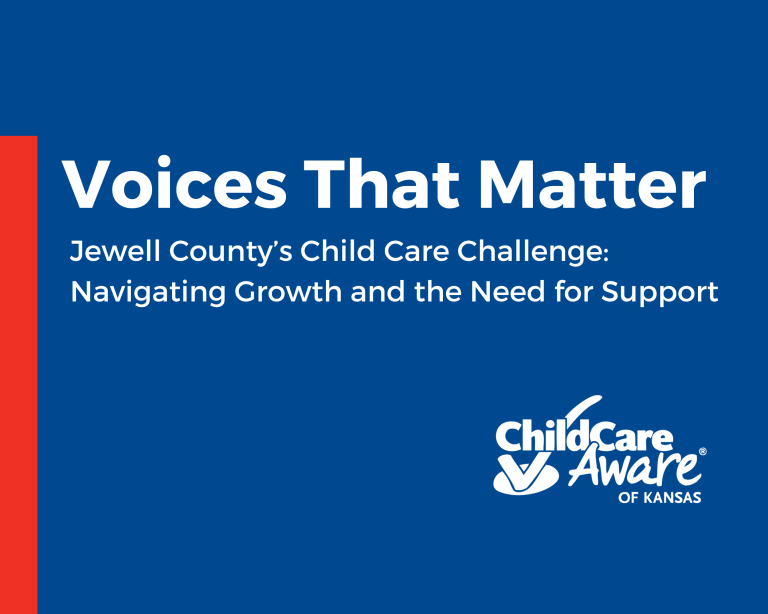A Community in Transition
Karla, a coalition leader in Jewell County, believes that her community is representative of the indomitable Kansan spirit. She and Jonna, a Community Outreach and Engagement Coordinator for Child Care Aware of Kansas, shared that this county has always been small, but a recent increase of young families moving back home to the area has caused a conundrum in their child care system.
As newer and returning families arrive in this rural farming community, they bring their children, and most notably, their infants. These infants require a greater number of available child care slots in the county, and those slots simply do not exist in the capacity to accommodate the needs of these families.
In addition to a lack of available child care options, Karla, as well as providers like Meghan, the director of a group child care home facility, and Emma, a mother of two children currently in child care, believe that a more effective flow of communication and increased funding would significantly benefit the child care system in their community.
Growing Pains: The Struggle to Meet Child Care Needs
As Karla, Emma, and Meghan concur, available child care means greater community growth. With the increase in families moving to Jewell County and existing child care providers not being able to keep up with the demand, their community is struggling to work through growing pains. In the challenge to find a way for information to flow effectively between their community, child care agencies, families, and providers, it is difficult for these parties to be able to understand the value and needs of one another, impeding the social growth of the county.
A lack of funding for providers and financial assistance for parents is resulting in child care needs remaining unmet, and this inhibits the economic growth of the community, who are pouring their paychecks into increasingly unaffordable child care for all involved. According to Emma, there is “less room to spare in the budget,” for families, making affordability seemingly impossible.
Meanwhile, providers like Meghan are throwing themselves into the wide-ranging needs of the children under their care with little compensation, making it more and more difficult to be able to afford to continue working in their field. Meanwhile, as providers are struggling to meet the needs of their community, there are fewer and fewer providers entering the field, and for families with infants and young children, this means that they have extremely limited options for child care.
Enhancing Information Flow Between Families, Providers, and Agencies
One way to buttress against these challenges, Karla and Emma shared, would be to create a more effective flow of communication among the community, child care agencies, providers, and families, with Jonna adding, “If they can’t see the problem, they won’t help.” In other words, readily available information and intentional education of all parties would result in a heightened awareness of child care needs in the area.
In addition, Emma believes, clearer and more centralized information about requirements, screenings, documentation, center policies, financial assistance, and other helpful materials would help parents better understand the needs of providers. More easily navigable information about regulations and licensing would help providers better understand the needs of child care agencies.
Understanding the struggles of parents and providers would better help child care agencies implement policy that would aid all parties. Furthermore, funding for parents and providers would assist both in fulfilling their needs, and therefore the needs of the community as a whole. “I want to make things better for generations to come,” Karla shared, and with financial assistance for parents and grant funding for providers, this could very well become a reality.
Though the child care needs of Jewell County are extraordinarily high, this is a community that is willing to find ways to adapt.
Alongside agencies like Child Care Aware of Kansas who aim to aid in facing these challenges, this is a community that has the potential to fulfill an increasingly dire need for available and affordable child care.
Karla shared that her coalition has gone above and beyond, and in their goal to give quality training and resources to existing providers, “We did what we said we were going to do.”
Now, this community needs outside support to create a more effective flow of information and communication, as well as opportunities for financial assistance and grant funding, so that Jewell County may benefit from available and affordable child care for all its citizens.
-

Casadie Smith
Casadie Smith, Director, StoryComm Solutions
Casadie Smith received her Master of Arts in Communication & Storytelling Studies from East Tennessee State University in 2023, where she focused on qualitative research and applied storytelling. Her years of varied experiences as a writer, creative, early childhood educator, curious mind, and much more have offered her unique insight into the importance of connecting people of all backgrounds through stories. Casadie currently works as a professional freelance storyteller, writer, researcher, and educator, and you can find more information about her services at https://www.casadiesmith.com.







